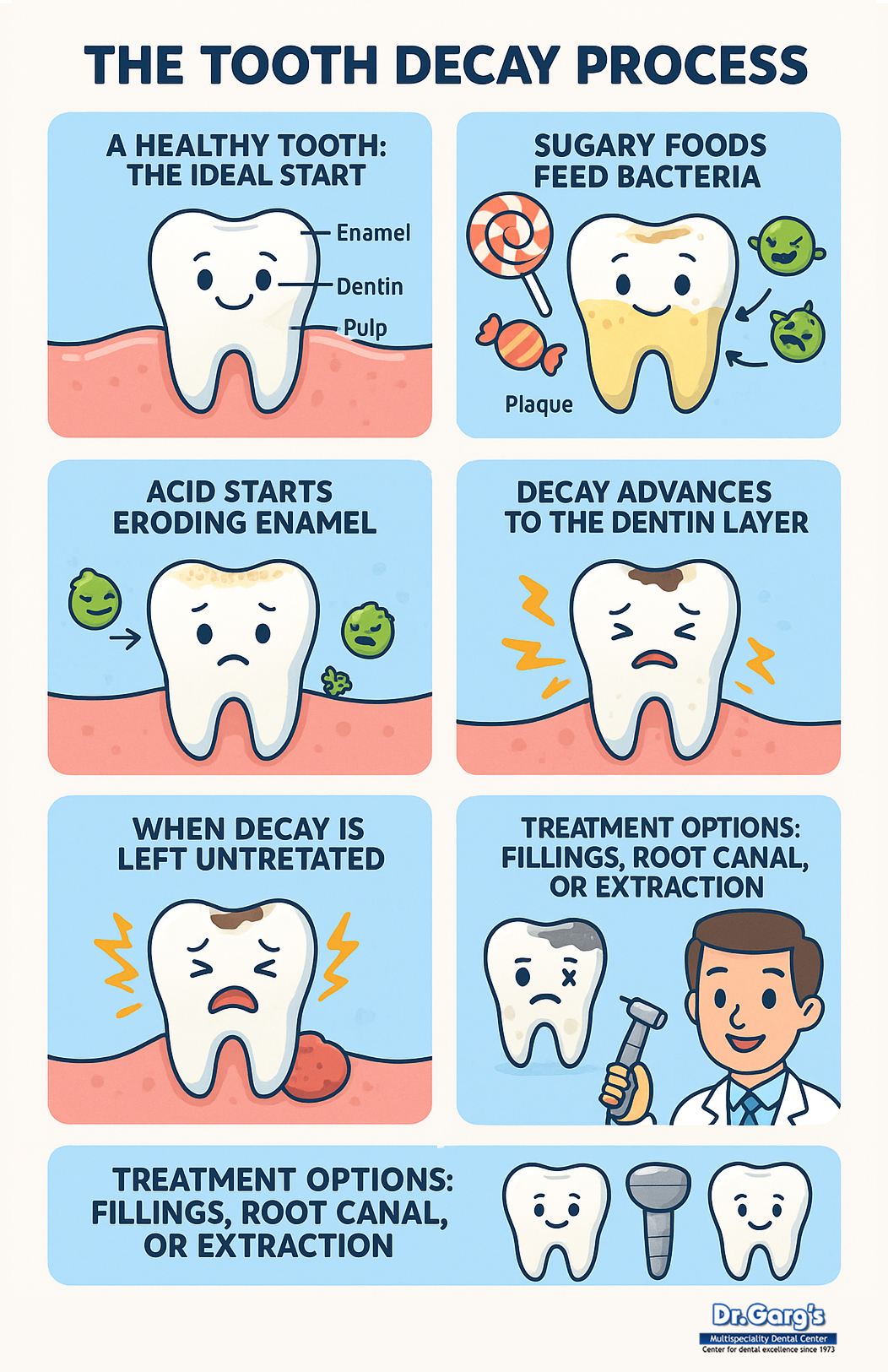Tooth Decay: The Complete Guide to Causes, Symptoms and Treatment (2025)
Most people think tooth decay is just about eating too much candy.
The truth is:
Tooth decay is a complex bacterial process that can silently damage your teeth over time. Oral diseases, including tooth decay, affect an estimated 3.7 billion people worldwide, making them some of the most widespread health conditions on the planet.
In this comprehensive guide, you’ll discover everything you need to know about tooth decay, including:
- The real science behind how cavities form (it’s not what you think)
- Early warning signs that most people ignore
- Modern treatment options that can save your teeth
- Prevention strategies that actually work
Let’s dive right in.
Chapter 1: What Is Tooth Decay (And Why It’s More Dangerous Than You Think)
Here’s the deal:
Tooth decay isn’t just about holes in your teeth. It’s a progressive bacterial infection that can lead to severe pain, tooth loss, and even life-threatening complications if left untreated.
The Science Behind Tooth Decay
Tooth decay happens when harmful bacteria in your mouth feed on food particles stuck between your teeth. This bacterial feeding frenzy produces acid as a waste product.
Here’s where it gets interesting:
These acids don’t just sit there. They actively attack your tooth enamel – the hardest substance in your human body. Over time, this acid assault creates tiny holes that grow bigger and deeper.
Think of it like this:
Your teeth are under constant attack. Every time you eat or drink something (especially sugary or starchy foods), you’re essentially feeding an army of bacteria that want to destroy your teeth.
Why Tooth Decay Spreads So Fast
Once a cavity starts, it creates the perfect hiding spot for more bacteria and food particles. This creates a vicious cycle:
More bacteria → More acid production → Bigger cavity → Even more bacteria
The scary part?
This process can happen incredibly fast. In some cases, a small cavity can become a major dental emergency in just a few months.
Chapter 2: The Hidden Causes of Tooth Decay (Most People Get This Wrong)

You might be wondering:
“If tooth decay is just about sugar, why do some people who eat candy all day have perfect teeth while others who barely touch sweets still get cavities?”
Great question.
The truth is, tooth decay has multiple causes that work together:
Cause #1: Poor Oral Hygiene (The Obvious One)
This one’s pretty straightforward. When you don’t brush and floss regularly, plaque builds up on your teeth. Plaque is basically a sticky film of bacteria that produces acid 24/7.
But here’s the kicker:
Even people who brush twice a day can still get cavities if they’re not doing it correctly.
Cause #2: Diet (It’s Not Just Sugar)
Sweet and sugary foods are definitely the biggest culprits. But starchy foods like bread, crackers, and chips can be just as bad.
Why?
Your mouth contains enzymes that break down starches into sugars. So even if you’re avoiding candy, you might still be feeding cavity-causing bacteria.
Cause #3: Dry Mouth (The Silent Killer)
Your saliva is like nature’s mouthwash. It neutralizes acids and washes away food particles and bacteria.
When you have dry mouth (from medications, medical conditions, or just genetics), you lose this natural protection. This is why some people seem cavity-prone no matter what they do.
Cause #4: Genetics (The Unfair Advantage)
Some people are born with naturally stronger enamel or better saliva production. Others have deeper grooves in their teeth that trap food more easily.
It’s not fair, but it’s reality.
Cause #5: Frequent Snacking (The Acid Bath Effect)
Every time you eat or drink something other than water, your mouth becomes acidic for about 20-30 minutes.
If you’re constantly snacking throughout the day, your teeth are basically swimming in acid all day long.
This is crazy:
Someone who eats three candy bars with their meals has less cavity risk than someone who sips on a sugary drink all day.
Chapter 3: Early Warning Signs of Tooth Decay (Don’t Ignore These)

Most people wait until they have a toothache before seeing a dentist.
Big mistake.
By the time you feel pain, the decay has usually reached the nerve of your tooth. At that point, you’re looking at root canal treatment or tooth extraction.
Here’s how to catch tooth decay early:
Stage 1: White Spots on the Enamel
This is one of the earliest visible signs. You might notice dull white patches on your teeth, especially near the gumline.
What’s happening:
Acidic plaque begins to demineralize the enamel. At this point, the tooth has not yet formed a cavity.
The good news: This stage is reversible with fluoride and proper oral care.
Stage 2: Tooth Sensitivity
You may feel a short, sharp sensation when consuming cold, sweet, or acidic foods.
What’s happening:
The enamel is weakening, and the underlying dentin is starting to become exposed. Sensitivity is an early warning that decay is progressing.
Stage 3: Visible Spots or Discoloration
You might see brown, black, or gray spots on a tooth. These may not always cause pain.
What’s happening:
Decay is now forming a cavity in the enamel. If ignored, it can spread deeper into the tooth structure.
Stage 4: Pain While Chewing or Biting
If you notice discomfort or pain when biting down, it’s time to pay attention.
What’s happening:
Decay may have reached the dentin or is close to the pulp. You might also find food getting stuck in the affected area.
Stage 5: Persistent or Throbbing Toothache
Pain that doesn’t go away is a serious warning.
What’s happening:
The infection has reached the pulp, the soft tissue inside the tooth. At this point, you may need root canal treatment to save the tooth.
Want to know the best part
If you catch tooth decay in Stage 1 or 2, the treatment is usually simple and affordable. A small filling or fluoride therapy can solve the problem quickly.
Don’t wait for pain. Visit your dentist regularly, and treat early signs before they turn into bigger issues.
Chapter 4: Modern Tooth Decay Treatment Options (What Actually Works)
The treatment for tooth decay depends entirely on how far it has progressed.
Here’s the breakdown:
Early Decay (Enamel-Only Damage)
Treatment: Simple Filling
When decay is limited to the outer enamel layer, a dentist removes the affected area and fills it using composite resin or glass ionomer.
Time required: 30–60 minutes
Cost range: ₹3,300 (approx. $40) per filling
Success rate: Over 95% when done early
This is often completed in a single visit and is a quick, effective fix if decay is caught in time.
Moderate Decay (Into the Dentin Layer)
Treatment: Filling with Protective Liner
If the decay extends into the dentin, a protective liner is placed before filling to reduce sensitivity and protect the nerve underneath.
Time required: 45–90 minutes
Cost range: ₹4,500 to ₹6,000 (approx. $55–$72)
Success rate: 90–95%
Advanced materials help ensure the tooth stays strong and sensitivity is kept to a minimum.
Deep Decay (Near or At the Nerve)
Treatment: Root Canal Therapy
When decay reaches the tooth’s nerve, the infected tissue must be removed. The area is then disinfected and sealed to prevent reinfection.
Time required: One to three appointments, 60–90 minutes each
Cost range: ₹12,300 (approx. $150)
Success rate: 85–95%
Root canal therapy is now much more comfortable thanks to modern tools and techniques.
Severe Decay (Extensive Damage)
Treatment Options:
- Crown placement for teeth that are too weak to function properly
- Extraction followed by replacement using implants, bridges, or dentures
Time required: Multiple appointments over several weeks
Cost range:
- Zirconia Crown: ₹13,000+ (approx. $160)
- Dental Implant with Crown: ₹40,000–₹60,000 (approx. $480–$720)
- Dental Bridge (per unit): ₹8,000–₹12,000 (approx. $100–$150)
The key takeaway:
If decay is caught early, treatment is fast, affordable, and minimally invasive. The longer you wait, the more complex and costly the treatment becomes.
| Stage of Decay | Treatment | Time Required | Approx. Cost | Success Rate |
| Early Decay(Enamel only) | Simple Filling (Composite/Glass Ionomer) | 30–60 minutes | ₹3,300 / $40 | Over 95% |
| Moderate Decay(Into Dentin) | Filling with Protective Liner | 45–90 minutes | ₹4,500 – ₹6,000 / $55 – $72 | 90–95% |
| Deep Decay(Near the nerve) | Root Canal Therapy | 1–3 appointments, 60–90 mins each | ₹12,300 / $150 | 85–95% |
| Severe Decay(Extensive) | Crown / Extraction & Replacement Options | Several appointments over weeks | ₹13,000 – ₹60,000+ / $160 – $720+ | Varies by case |
Chapter 5: Prevention Strategies That Actually Work
Here’s what most dental advice gets wrong:
It focuses on what NOT to do instead of giving you actionable strategies that fit into real life.
Let me fix that.
The 2-Minute Rule
Brush for at least 2 minutes, twice a day. But here’s the advanced technique most people miss:
Brush in a specific pattern to make sure you don’t miss any spots:
- Start with the outside surfaces of your upper teeth
- Move to the inside surfaces of your upper teeth
- Brush the chewing surfaces of your upper teeth
- Repeat for your lower teeth
The Flossing Secret
Most people floss wrong. Here’s the right way:
Use about 18 inches of floss, wrapping most of it around your middle fingers. Use your thumbs and index fingers to guide the floss between your teeth using a gentle rubbing motion.
The key:
Curve the floss into a C-shape against each tooth and slide it into the space between the gum and tooth.
The Fluoride Strategy
Use a fluoride toothpaste and don’t rinse immediately after brushing. This leaves a protective fluoride coating on your teeth.
For high-risk patients, dentists sometimes recommend prescription-strength fluoride treatments.
The Smart Snacking Approach
Instead of avoiding all sweets (which isn’t realistic for most people), follow these rules:
- Eat sweets with meals rather than as standalone snacks
- Choose sweets that dissolve quickly rather than sticky ones
- Drink water or rinse after eating sugary foods
- Wait at least 30-60 minutes after eating before brushing (acid temporarily softens enamel)
The Saliva Hack
Chew sugar-free gum after meals to stimulate saliva production. Xylitol-containing gum is especially effective because xylitol actually inhibits cavity-causing bacteria.
Chapter 6: When to See a Dentist (Don’t Wait for Pain)
Most dental problems are much easier and cheaper to fix when caught early.
Here’s when you should see a dentist:
Immediately:
- Severe tooth pain
- Swelling around teeth or gums
- Fever with dental pain
- Trauma to teeth
Within a week:
- Mild tooth sensitivity that persists
- Visible dark spots on teeth
- Rough or sharp edges on teeth
- Food constantly getting stuck in the same spot
Routine care:
- Every 6 months for cleanings and checkups
- More frequently if you’re high-risk for decay
The Bottom Line
Tooth decay is preventable and treatable, but only if you take action early.
The key points to remember:
- Tooth decay is a bacterial infection, not just “weak teeth”
- Early detection saves time, money, and pain
- Prevention is always better than treatment
- Modern treatments are more comfortable than ever
- Professional care is essential – you can’t DIY your way out of serious decay
Your next step?
Schedule a dental checkup if you haven’t had one in the past 6 months. Many dental problems have no symptoms until they’re advanced, so regular professional dental care is your best defense against tooth decay.
Remember: A small filling today is always better than a root canal tomorrow.



Leave a Reply
Want to join the discussion?Feel free to contribute!